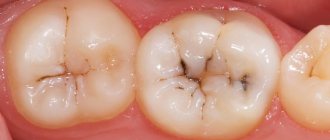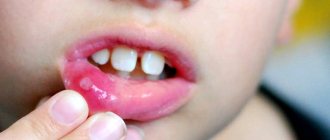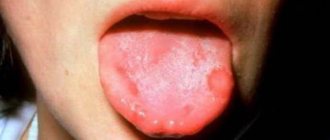Stomatitis is irritation or damage to the mucous membranes of the oral cavity. It appears in the form of ulcers and so-called “pimples” filled with liquid.
It is useful to study medical photographs to know exactly what they look like and contact the hospital in time. Stomatitis can appear in both adults and children, but it is children who are most predisposed to it. The disease equally affects children both at 4-5 months of age and at 4-5 years of age.
Stomatitis in children is explained by the underdevelopment of the mucous membranes, from which they are easily damaged by the slightest influence of any factor. Do not forget that children constantly put dirty hands, toys and various objects into their mouths. The development of bacteria and microorganisms is a powerful impetus for the occurrence of stomatitis. Children also experience frequent disruptions in the gastrointestinal tract, which increase acidity and change the composition of saliva. Such changes lead to problems.
Classification
Depending on the cause of occurrence, there are the following types of stomatitis:
- Allergic – occurs when the body is exposed to an external agent. A common occurrence in young children that is difficult to treat.
- Vesicular – the disease has a viral etiology. A child becomes infected due to contact with an insect carrier or a sick animal.
- Aphthous - is a consequence of advanced stomatitis of herpes etiology.
- Catarrhal – characterized by a blurred clinical picture and a tendency to become chronic.
- Traumatic – occurs after injury to the mucous membrane and is dangerous due to infection. A common occurrence in children aged 3 years, associated with injuries and the lack of a well-developed technique for brushing teeth.
- Herpetic – occurs due to infection with the herpes simplex virus. Often occurs in children 1 year and older.
- Ulcerative - can be either an independent form or a complication of catarrhal stomatitis.
- Viral (infectious) – caused by influenza virus, parainfluenza, chickenpox, measles, adenovirus.
- Candidiasis - occurs as a result of the proliferation of fungi of the genus Candida in the oral cavity. Most often occurs in one-year-old children and in children under 2 years of age.
- Bacterial - the causative agents are staphylococci and streptococci. This type includes gonorrheal and diphtheria stomatitis.
Definition and types
Stomatitis is a disease of the oral cavity associated with inflammation of the mucous membranes as a result of the action of pathogenic factors of various natures. The disease mainly affects children from infancy to 5-6 years of age. This is due to the high vulnerability of the immune system due to its immaturity during this age period. The mucous membrane in children is very thin and is easily damaged and infected, causing stomatitis.
According to the nature of the disease and the characteristics of its genesis, the following types of stomatitis are distinguished:
- Herpetic stomatitis caused by the virus of the same name. Near 80% of cases The disease falls precisely on this form. The infectious nature of the disease involves infection through contact with people who are carriers of the herpes virus, as well as through the use of shared objects (toys, dishes, personal hygiene items). Once the infection enters the body, it remains there for life. In this case, the primary signs of stomatitis are expressed in an acute form, and subsequent ones are already chronic in nature and recur over several years.
Viral stomatitis is a consequence of not only herpes, but also other infections: chicken pox, influenza, rubella, etc. True, this happens much less often.
In infants, the incidence of herpetic stomatitis increases from the age of six months, since by this time the antibodies received from the mother disappear, and their own immunity is too weak to resist infection.
- Aphthous stomatitis. It occurs in children suffering from chronic infections and gastrointestinal diseases who are prone to allergies. Stomatitis manifests itself periodically (has exacerbation phases) and is characterized by painful symptoms of mild, moderate and severe severity.
- Bacterial stomatitis. The disease occurs in children of all ages and is provoked by the development of a bacterial infection on the damaged mucous membrane of the oral cavity. Injury can occur as a result of eating too hot or hard food, teething, or getting foreign objects (toys, etc.) into the mouth. The causative agents of the disease are: staphylococci, streptococci, tuberculosis bacillus and other pathogenic microflora.
- Fungal stomatitis. This form of the disease occurs most often in newborn babies who are breastfed. The disease occurs due to the fungal activity of the genus Candida, which parasitizes the baby’s mouth when consuming breast milk. Hence the second name of the pathology – thrush. However, infection can also occur during childbirth if the baby’s mother has untreated vaginal candidiasis.
- Allergic stomatitis occurs as a characteristic inflammatory reaction to any irritant, often associated with other forms of disease: bacterial, fungal or viral.
Useful: Reasons for increased testosterone in women
Reasons for the development of stomatitis
Most often, children under 3 years of age are susceptible to the disease, but this does not mean that at another age your child will not be at risk of a dangerous and insidious disease. The immune system of babies is not yet fully functional; the tissues of the oral mucosa are very soft and thin, so putting dirty hands or objects into the mouth in some cases leads to illness.
Many doctors classify childhood stomatitis as any damage (even mechanical) to the oral mucosa or infectious diseases of the oral cavity.
The most common causes of childhood stomatitis may be:
- Entering the oral cavity of the fungus candida (popularly called thrush). A weakened child’s immune system is an ideal condition for the rapid progression and proliferation of a fungal virus. The mouth may become dry and white. Untimely treatment leads to the appearance of cracks, accompanied by unbearable pain while eating.
- The herpes virus can also cause the development of childhood stomatitis. This is a dangerous pathogen that is transmitted through household items, dishes and toys. In 99% of cases, the disease affects children under 3 years of age.
- Bacterial stomatitis occurs due to the child’s habit of not washing his hands after visiting the toilet or after coming in from outside. Children put everything that surrounds them into their mouths, so repetitions and relapses of the disease are possible in the future.
- The causes of aphthous stomatitis have not yet been identified. Doctors argue about who is the causative agent of this form of the disease: bacteria, viruses or herpes. Aphthous stomatitis can easily become chronic.
- Stomatitis is often caused by mechanical damage to the oral cavity and mucous membranes, which a child receives during falls or scratches from a foreign object. Stomatitis may also occur during teething.
Since there are many causes of childhood stomatitis, each child should be observed individually. Even if you look at photos of stomatitis in children’s mouths, they will vary greatly.
General symptoms of stomatitis, photos in children
General symptoms that can be observed with any form of stomatitis in children (see photo) include:
- the appearance of ulcers in the mouth, the size, lesions and color of which can vary greatly depending on the type of stomatitis;
- changes in the child’s behavior – tearfulness, irritability, worsening sleep and appetite.
Symptoms of aphthous stomatitis in children:
- A few days before the development of the disease, a characteristic symptom, the so-called geographic tongue, is observed. The tongue becomes covered with small blisters. After a day or two, the next period of illness begins: aphthae on the oral mucosa and an increase in body temperature. The child complains of a burning sensation in the mouth and refuses food and water. Often, in addition to bubbles, a white coating is observed on the tongue. The number of aphthae on the oral mucosa in aphthous stomatitis is much less than in herpetic stomatitis. Usually there are no more than one or two or five or six ulcers. The herpetic form is characterized by a large number of ulcers that cover the child’s entire mouth.
Symptoms of herpetic stomatitis:
- simultaneous appearance of aphthae of almost the same size and configuration on the oral mucosa in several places at once;
- a wave-like course of the disease, manifested in the initial period by a rash of painful ulcers and a sharp increase in body temperature. Then the temperature stabilizes and the child’s general condition improves. After a few days, a relapse develops - new rashes appear, and the temperature begins to rise;
- swelling of the gums;
- bad breath.
Symptoms of candidal stomatitis:
- The development of specific local symptoms of candidal stomatitis in children is preceded by excessive dryness of the mucous membrane, a burning sensation and an unpleasant taste in the mouth, and bad breath. Infants are capricious while eating, refuse the breast or bottle, behave restlessly, and sleep poorly. Soon, small white dots appear on the inside of the cheeks, lips, tongue and gums, which, merging, form a rich white plaque of a cheesy consistency. In severe forms of candidal stomatitis in children, the plaque acquires a dirty gray tint and is difficult to remove from the mucous membrane, revealing a swollen surface that bleeds at the slightest touch. In addition to pseudomembranous candidal stomatitis described above, atrophic candidal stomatitis occurs in children. It usually develops in children wearing orthodontic appliances and occurs with scant symptoms: redness, burning, dryness of the mucous membrane. Plaque is found only in the folds of the cheeks and lips.
Symptoms of bacterial stomatitis:
- When affected by various types of bacteria, the symptoms of the disease in children have characteristic features. Thus, when the oral cavity is affected by the causative agent of diphtheria, the bleeding surface of the gums is covered with a grayish film. The appearance of a white coating on the tongue in the presence of stomatitis indicates that the cause of the disease is scarlet fever. Sometimes a newborn baby becomes infected while passing through the birth canal. For example, if the mother is sick with gonorrhea, then signs of infection of the baby may be the presence of redness and ulcers in the mouth, as well as inflammation of the conjunctiva of the eyes.
Symptoms of viral stomatitis:
- Symptoms of a viral disease of this kind are fever, moody mood, swelling of the submandibular lymph nodes, swelling of the jaws and palate, the appearance of aphthae (painful ulcers), and bad breath. A sick child can infect other children and adult family members.
A common common symptom of any type of stomatitis is enlargement and tenderness of the lymph nodes under the lower jaw.
The main symptoms of childhood stomatitis
The disease develops in several main stages, each of which is characterized by certain symptoms:
- The initial signs of stomatitis can be almost the same as with ARVI: appetite decreases, weakness and malaise appear, nausea and enlarged lymph nodes. Body temperature can increase only with the herpetic type of stomatitis (up to 40 degrees) . The mucous membrane of the mouth has a reddish tint.
- After a few days, the mouth may become covered with white spots or plaque. At this stage, timely measures should be taken to treat stomatitis.
- 3-5 days after the first symptoms of childhood stomatitis appear, white sores may be detected on the lips, gums and cheeks.
It is important for parents to prevent the disease from progressing quickly without attention from the dentist, so that the disease does not become chronic.
How to treat stomatitis in a child at home
As a reasonable parent, you should contact your doctor (pediatrician) if you find that:
- The child is unable to drink or swallow food.
- The child has a high temperature.
- The child is too fussy and cannot be calmed down.
- The child sleeps restlessly at night, or does not sleep at all.
- Bubbles and a light white coating appeared on the baby's tongue.
Treatment of stomatitis in children directly depends on the causes that caused it. The following treatment strategy is common to all types of stomatitis in children:
- A gentle diet with the exclusion of any solid foods that can “disturb” aphthae in the oral cavity and cause an exacerbation of inflammation. You should also remove spicy and sour foods from your diet, and make sure that the food is not too hot.
- Thorough oral hygiene: gentle brushing of teeth and tongue, as well as daily rinses with antiseptic agents.
- If a child's temperature rises above 38.5°C, he should be given an antipyretic medicine.
If you follow a gentle diet and proper oral hygiene, aphthae (ulcers) completely disappear 10-15 days after their appearance in any type of stomatitis.
To rinse your mouth during the day, you can use solutions of antiseptics - chlorhexidine, furatsilin, etc., as well as herbal decoctions - chamomile, calendula and others. The attending physician will tell you how to properly prepare the solution, and will also prescribe a rinsing regimen (it varies depending on the age of the child and the severity of his illness). In addition, if the ulcers are large and painful to the point that the child is acting too hysterically, the canker sores can be treated with antiseptic sprays from time to time.
However, remember that for stomatitis in children, aerosols should under no circumstances be used on children under one year of age. Pharmacy gels, which are usually used to relieve itching when the first teeth erupt, will help these crumbs relieve pain.
It is also recommended to temporarily “transfer” the child to a toothbrush with the softest bristles, but at the same time he must brush his teeth and gums very carefully.
Pediatric stomatitis can be aggravated by sharp edges of teeth or braces in the mouth - these problems are best addressed in the pediatric dentist's office.
Basic methods of treating stomatitis in a child’s mouth
After examining the child, the dentist must prescribe appropriate medications that will be most effective for different types of stomatitis. Only a specialist can decide how to treat stomatitis in children.
Be sure to give your baby water as much as possible, so that clean water “irrigates” the mucous membrane of the mouth, and also gradually removes intoxication products from the body.
Not only bottled water can be used as a drink, but also homemade fruit drinks, compote and herbal teas. Sweet, sour and chocolate foods should be excluded from the diet . Carbonated drinks and natural juices are contraindicated, as they will cause severe pain.
One of the stages of treatment of childhood stomatitis is anesthesia of the mucous membrane . Firstly, it allows the child to eat and drink painlessly, and also reduces overall stress. For pain relief, medications containing lidocaine or choline salicylate can be used.
Drugs that are used for pain relief during teething in children are well suited at this stage: Dentinox-gel or Kamistad. Gels are more effective because they are absorbed faster into the oral . It is strictly forbidden to use sprays in children under 1 year of age, since their spraying can cause bronchospasm.
Wounds and ulcers must be treated with special agents that kill stomatitis pathogens.
Treatment of wounds and ulcers on the oral mucosa involves applying a cream or solution not only to the damaged area itself, but also to the area around them. This helps prevent further spread of the infection.
It would not be superfluous to use products aimed at healing damaged areas. Among them I would like to note: Solcoseryl, Actovegin or Vinilin balm.
Special attention is paid to oral hygiene. The child should brush his teeth at least 2 times a day, and after eating, the mouth should be rinsed every time !
For the youngest children, these procedures can be performed with clean fingers or special tampons.
Treatment of viral stomatitis
Antiviral ointments containing acyclovir are ideal for the treatment of herpes stomatitis (viral) . Among them, Virolex, Gerpevir and Viferon stand out.
If viral stomatitis recurs periodically, dentists recommend taking a course of strengthening the immune system with the medication Interferon, Immunal or Viferon in suppositories. The duration of treatment and the drugs used are determined only by the attending physician .
Cholisal gel has proven itself well. The drug is based on choline salicylate. It fights viruses, fungi and microbes in the body, relieves heat, swelling and redness of mucous membranes. Used in children under 1 year of age without side effects.
The gel can be applied to your finger and massaged onto the oral mucosa (in particular the gums). The manipulation should be carried out at least 2 times a day.
Treatment of candidal stomatitis
If stomatitis in a child is caused by fungi, then Candide, Candizol and Clotrimazole ointments will help to cope with it. Even simple rinses of the mouth with soda, which are recommended by dentists, will help .
This is done so that after rinsing with baking soda, an alkaline environment is formed in the mouth, in which most microbes and viruses die.
Rinsing with soda is carried out in children under one year old, since all existing antifungal drugs are strictly contraindicated for them..
A tablespoon of water should be diluted in a glass of warm water. A pre-prepared tampon or a piece of bandage is dipped into the resulting liquid, which is then used to lubricate the oral mucosa.
Similar treatments are carried out after each feeding, but we should not forget about the space under the baby’s tongue, where pathogenic viruses can also be located.
Treatment of aphthous stomatitis
Treatment of aphthous stomatitis requires the use of painkillers and regenerative agents. Until now, blue remains the most common and effective drug for these purposes.
Use only an aqueous solution. It should absolutely not be replaced with a solution containing ethyl alcohol, which can cause burns to the oral mucosa.
It is recommended to treat a child’s oral cavity with blue at least 3 times a day by soaking a cotton swab in the solution and then applying it to the damaged areas.
Treatment of traumatic stomatitis
The first 2 years of a child’s life are accompanied by a high risk of traumatic stomatitis. It is accompanied by the penetration of a bacterial infection into the oral mucosa, therefore, during the treatment of traumatic stomatitis in a child, antiseptic and wound-healing drugs must be used.
Children under 2 years of age can use the following gels: Actovegin, Solcoseryl and Cholisal.
Is your wisdom tooth growing and your gums hurting badly? Find out how to get rid of pain. Here https://home-stomatolog.ru/bolit-zub-posle-plombirovaniya-pri-nakusyvanii-prichiny-posledstviya-i-metody-lecheniya.html we have already written about what to do if the tooth hurts after filling.
Treatment of bacterial stomatitis
Many parents do not even realize that treatment of bacterial stomatitis in their children should be effective and timely. The most effective and common means for this are Orasept, Tantum Verde and Septolete lozenges.
It is not recommended to give Septoleta lozenges to children under 6 years of age, as there is a risk of asphyxia.
We also recommend paying attention to the antiseptic gel with metronidazole - Metrogil-denta.
Treatment of aphthous stomatitis in children
Treatment of this stomatitis, due to the uncertainty of the cause, is carried out by several doctors, this may be a dentist, an allergist or a gastroenterologist.
- If the allergic nature of the occurrence of aphthous stomatitis is established, then contact with the allergen is excluded, antihistamines are prescribed - Suprastin, Cetrin in syrup (children over 2 years old), see all allergy medications.
- Solutions of soda, boric acid, herbal decoctions, and Blue are also used to treat canker sores.
- The selection of antiseptic and antimicrobial agents is often carried out by trial and error, since the course of any inflammatory process is individual, for some people help with Lugol's spray, Hexoral spray, or rinsing with Iodinol, Miramistin, for others Vinilin or methylene blue dye - Blue - helps a lot. Rotokan, an antiseptic with a healing effect (for mouth rinsing), has proven itself well.
- If gastrointestinal disorders are detected, then appropriate treatment of the concomitant disease is carried out.
- Vitamins C, B1, B2, B12 are prescribed.
- Among the antiviral drugs, Bonafton can be prescribed.
- In case of chronic stomatitis, an immunologist can prescribe Decaris and Pyrogenal to correct immunity.
However, in any case, you should not self-medicate; treatment of stomatitis in children should be under the supervision of a qualified doctor.
How to treat fungal stomatitis
To treat this type of disease, your doctor may prescribe the following medications:
- Methylene blue, Fucorcin or boric acid. They are applied pointwise to erosions in young children and used as a rinse for older children.
- Nystatin ointment, Clotrimazole, Pimafucin cream. The preparations are applied to the oral mucosa, paying special attention to the cheeks and gums.
- Nystatin - tablets, crushed into powder, applied to erosions and ulcers.
- Candida in the form of a cream, gel or solution.
- Older children and adolescents may be prescribed Diflucan or Fluconazole by mouth.
- Vitamin therapy to improve immunity, Imudon tablets for children from 3 years old.
- Antipyretic drugs (Paracetamol, Panadol, Nurofen) for fever.
Treatment of herpetic stomatitis
When an acute process develops, which is accompanied by severe symptoms, the child is hospitalized and given symptomatic treatment in the hospital. In cases of mild to moderate severity of the inflammatory process, treatment can be carried out on an outpatient basis. The diet, as with candidal stomatitis, should exclude spicy, salty foods, canned food, and sour foods, especially citrus fruits. For herpes stomatitis in a child, treatment involves local procedures, as well as the use of general therapeutic agents:
- To ensure an anti-inflammatory effect, it is best to treat the affected areas of the mucous membrane in children 3-4 times a day with herbal decoctions - chamomile, sage, Kalanchoe juice; for these purposes, use cotton swabs soaked in the decoction. Pharmacies sell ready-made collections of such herbs (“Evkarom”, “Ingafitol”), which are suitable for rinsing the mouth and treating ulcers in older children.
- As a pain reliever for children over 4 years old, you can use the local antiseptic "Stomatidine", which has a weak analgesic and antimicrobial effect on the oral mucosa, you can also use "Hexoral Tabs" - lozenges with Chlorhexidine and Benzocaine, this drug has a local antimicrobial and analgesic effect.
- Treatment of ulcers with propolis is very effective, for example, “Propolis spray”, has a restorative effect in the presence of any skin lesions, herpes, ulcers.
- Antiherpetic ointments are used for local treatment - Tebrofen ointment, Viru-merz-serol, Oxolinic ointment, Acyclovir, Zovirax.
- Bonafton, an antiviral drug that is used to treat herpetic stomatitis, can be used.
- The healing of wounds is promoted by “Kaotolin” - an oil solution containing sea buckthorn oil, vitamin A and rosehip oil.
- Shostakovsky's balm, also known as "Vinilin", also has an anti-inflammatory effect, accelerates the process of tissue regeneration, epithelization and healing.
- Among the antiseptic agents used are Rotokan, Miramistin, and Lugol.
- In case of frequent relapses, the doctor may prescribe antiviral drugs for oral administration, in tablet form, Acyclovir, Valtrex.
- Vitamin therapy is also indicated in the form of Imudon lozenges, which are taken 6-8 times a day for one week.
Treatment of stomatitis: basic scheme
Any type of stomatitis must be treated, otherwise the number of ulcers may increase manyfold and re-infection will occur. In addition to treating the symptoms of the disease, you need to take care of strengthening the immune system, since stomatitis in a one-year-old baby is a sign of its weakness. Without treatment, stomatitis will recur for a long time and become chronic.
- The answer to the question of how to cure stomatitis in a child will depend on the causative agent of the disease. The basic rule is: antimicrobial for bacterial infections, antifungal for thrush, antiviral for herpes, and antihistamine for allergic reactions.
- In addition to medicine that acts on the disease from the inside, you need to use local remedies to relieve burning and pain (Kalgel, Bebident, etc.).
These same agents ensure the intensity of the healing process and tissue regeneration. - Rinse to cleanse the mouth: infusions of anti-inflammatory herbs - St. John's wort, calendula, sage, oak bark.
- Treatment of stomatitis is accompanied by drinking plenty of fluids so that the pathogens are washed off from the mucous membrane.
- A diet high in vitamins A, C, and B is recommended.
- For high temperatures, use antipyretics.
Features of treatment of infants
Infants should be given water or weak chamomile tea frequently.
Feeding is carried out after anesthesia with a special gel, which is applied to the baby’s gums with a finger wrapped in gauze or using a cotton swab. Ointments are applied in the same way. If treatment with acyclovir is prescribed, it is applied in the form of an ointment to the mother's nipple.
To alleviate the condition of stomatitis, doctors sometimes recommend using a solution of soda, infusions of chamomile and calendula to rinse the mouth at home. To prepare them, take 20 g of flowers per 1 glass of boiling water. After cooling, the mixture is filtered. In addition, it is recommended to treat the baby's mouth with carrot juice. Children over 1 year old can lubricate their gums with rosehip, linseed or sea buckthorn oil, which have a good healing effect.
We destroy pathogenic microorganisms
If the cause of the disease is pathogenic microorganisms, you need to use antiseptics.
For this purpose, a Chlorophyllipt oil solution is suitable, in which you need to moisten a cotton swab and lubricate the affected areas no more than three to four times a day. Instead of a solution, you can purchase the drug in the form of a spray: two injections three times a day. The product should not be used if the tissue of the mucous membrane of the upper respiratory tract is depleted.
Good results are shown by Lugol solution or spray. Use no more than six times a day. Contraindications include diseases of the kidneys, liver, endocrine system, and skin rashes.
Phytotherapy
To rinse the mouth for stomatitis, decoctions, infusions and solutions prepared from medicinal herbs or herbal preparations are used.
For decoctions use:
- chamomile,
- flax seeds,
- oak bark,
- lingonberry leaves,
- burdock root or elecampane.
Method of preparation: chop the herb, pour boiling water and keep on fire for 10 minutes. Then remove from heat, cool, strain. Store the prepared broth in the refrigerator for three days.
To prepare the infusion, the crushed herb is placed in a container with a tight lid, poured with boiling water and infused. The infusion is used to prepare a solution (water or alcohol). Infusions are prepared from the following medicinal herbs:
- calendula;
- St. John's wort;
- sage;
- anise fruit;
- yarrow.
Rinsing the mouth during stomatitis facilitates the course of the disease, stops the inflammatory process, and prevents the development of possible complications.
Diet and nutrition
Despite the fact that during stomatitis a child cannot eat many foods, the diet must be balanced. It is important to ensure that your baby’s diet includes carbohydrates, proteins and fats. Dishes should not be hot, but not cold, and in a processed form (without large solid particles).
Sample list of products:
- dairy and fermented milk products without dyes and flavoring additives;
- non-acidic fruits (bananas, melon, watermelon);
- vegetables and juices from them;
- liquid porridge;
- homemade milk ice cream (cold relieves swelling and pain);
- teas and herbal infusions;
- ground lean meat or fish.
It is advisable to cook your child meatballs, steam cutlets, and not chops or steaks. Steam the fish or stew it with vegetables. At first, you should avoid sour fruits, try to salt your dishes less, and do not use spices. Do not buy your baby crackers, bagels, or hard cookies.
Fermented milk products can cause pain while eating, so they can be offered after pain relief.
The baby's nutrition remains unchanged. You just have to try to treat the oral mucosa after feeding and periodically offer him water.
Recommendations for parents
With stomatitis, children can only be given soft food with a temperature no higher than 30° (porridge or soup processed in a blender), chicken broth. You should not give sour or sweet juices. If your child has difficulty drinking water or tea, you can give him a straw. The body must not be dehydrated.
The room where the child is during treatment should have moist, cool air so that the child’s mouth does not dry out. Parents need to thoroughly disinfect pacifiers, feeding bottles, and teething aids. You cannot taste the child’s food with the same spoon that will later be used to feed him or lick his pacifier.
Children from a very early age should be taught how to brush their teeth and shown how to rinse their mouth. You can brush your teeth only with children's toothpastes. To prevent caries and timely dental treatment, it is necessary to regularly take children to the dentist.
Prevention
To prevent the appearance of stomatitis in early childhood, simple preventive work can be carried out. Pediatrician Evgeny Komarovsky gives useful recommendations for the prevention of stomatitis. In his video lesson, Komarovsky reveals this topic in detail. Main recommendations:
- Personal hygiene. This also applies to the oral cavity and general cleanliness. It is necessary to regularly wash your hands, toys, brush your teeth and rinse your mouth.
- Strengthening the immune system. Adequate intake of vitamins, proper daily routine, walks in the fresh air, physical activity.
- Resistant to bacteria. You should not keep your child in greenhouse conditions. Provided hygiene and normal immunity are maintained, he should play with other children, get dirty and have fun. This makes the child less vulnerable to the environment.
Streptoderma Oral candidiasis Chickenpox in children Seizures in the corners of the mouth: causes and treatment in adults Bad breath: causes and treatment in adults Worms in children: symptoms and treatment at home for worms in a child
Prevention of childhood stomatitis
The main preventive rule is the child’s personal hygiene. Parents should pay attention to ensure that the child does not lick various objects and dirty hands.
There is an opinion that breastfed children are less susceptible to various forms of stomatitis.
Older children should definitely wash their hands and brush their teeth. Only this is a kind of guarantee that your child will be able to avoid this difficult and at the same time such an unpleasant disease, which in some cases leaves a serious imprint on the general condition of the teeth.
We hope that now, at the first signs of stomatitis, you will be able to independently decide on the necessary list of actions.











